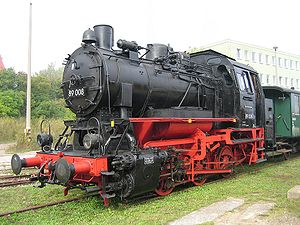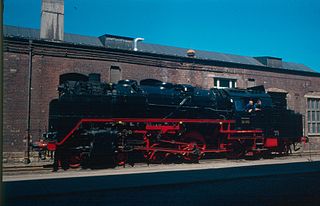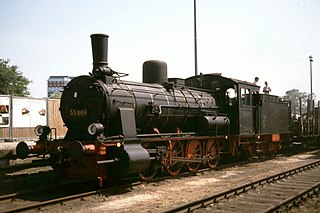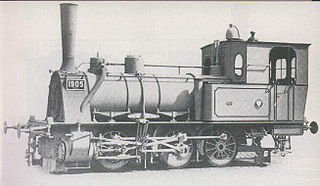This article needs additional citations for verification .(June 2021) |
| DRG Class 89.0 | |||||||||||||||||||||||||||||||||||||||||||||||
|---|---|---|---|---|---|---|---|---|---|---|---|---|---|---|---|---|---|---|---|---|---|---|---|---|---|---|---|---|---|---|---|---|---|---|---|---|---|---|---|---|---|---|---|---|---|---|---|
 89 008 in Schwerin | |||||||||||||||||||||||||||||||||||||||||||||||
| |||||||||||||||||||||||||||||||||||||||||||||||
| |||||||||||||||||||||||||||||||||||||||||||||||
| |||||||||||||||||||||||||||||||||||||||||||||||
| |||||||||||||||||||||||||||||||||||||||||||||||
The DRG Class 89.0 was a goods train tank engine of standard design (see Einheitsdampflokomotive ) built for the Deutsche Reichsbahn (DRG).
This article needs additional citations for verification .(June 2021) |
| DRG Class 89.0 | |||||||||||||||||||||||||||||||||||||||||||||||
|---|---|---|---|---|---|---|---|---|---|---|---|---|---|---|---|---|---|---|---|---|---|---|---|---|---|---|---|---|---|---|---|---|---|---|---|---|---|---|---|---|---|---|---|---|---|---|---|
 89 008 in Schwerin | |||||||||||||||||||||||||||||||||||||||||||||||
| |||||||||||||||||||||||||||||||||||||||||||||||
| |||||||||||||||||||||||||||||||||||||||||||||||
| |||||||||||||||||||||||||||||||||||||||||||||||
| |||||||||||||||||||||||||||||||||||||||||||||||
The DRG Class 89.0 was a goods train tank engine of standard design (see Einheitsdampflokomotive ) built for the Deutsche Reichsbahn (DRG).
It was the smallest standard locomotive in service with the Reichsbahn. Whilst numbers 89 001 - 89 003 were supplied as saturated steam engines, the remaining seven were superheated locomotives. After the Second World War half the machines went to the Polish State Railway (PKP) and half to the East German Deutsche Reichsbahn (DR). The last engine 89 008 was taken out of service in 1968 at Dresden-Altstadt locomotive depot (Bahnbetriebswerk or Bw) and remains preserved in the Dresden Transport Museum as a heritage locomotive. Since 1992 the engine has been in the ownership of the Mecklenburg Railway Friends (Mecklenburgischen Eisenbahnfreunde) in Schwerin.
Although this engine was never in service with the Deutsche Bundesbahn, it is in the DB's transport directory.
A Z scale model of the Class 89.0 locomotive has been used as the symbol for this model track gauge.
There has also been a model by the firm of Märklin for decades in H0 scale. The DB variant of this model has no real prototype, however, because this engine was never in the DB's fleet.

The Deutsche Reichsbahn had a standard passenger train tank engine with a wheel arrangement of 1'C1' or 2-6-2 and a low axle load, which was designated in their classification system as the DRG Class 64. The Class 64 was developed from 1926 onwards and it was built between 1928 and 1940. Many German manufacturers contributed to the series.

The DRG Class 86 was a standard goods train tank locomotive with the Deutsche Reichsbahn-Gesellschaft. It was intended for duties on branch lines and was delivered by almost all the locomotive building firms working for the Reichsbahn. From 1942 it was built in a simplified version as a 'transitional war locomotive'. The most obvious changes were the omission of the second side windows in the cab and the solid disc carrying wheels.

The Bavarian Class D XII steam locomotives were manufactured by the firm of Krauss from 1897 for the Royal Bavarian State Railways. Ninety six of them were procured for service on the stub lines running from Munich into the mountains, but in reality they were stationed in many large Bavarian locomotive depots. Two engines were transferred to the Palatinate Railway (Pfalzbahn) in 1916, the remaining 94 later joined the Deutsche Reichsbahn fleet and were incorporated as DRG Class 73.0-1 with operating numbers 73 031–124.

The Bavarian Class R 3/3 of the Royal Bavarian State Railways was an 0-6-0T intended for goods trains. Of the engines delivered before World War I, one went to the Polish PKP, the other 17 were included by the Deutsche Reichsbahn as Class 89.7 in their numbering plan. The 90 units of the second series that were supplied from 1921 onwards all went into the Reichsbahn, and were designated as Class 89.8. 86 examples went into the Deutsche Bundesbahn after the Second World War and the last one was not taken out of service until 1960.

The Class 80 tank engines were German standard locomotives (Einheitsloks) with the Deutsche Reichsbahn. They were intended to replace the aging, rickety state railway line engines performing shunting duties in their dotage at large stations.

The Class 62 engines were standard passenger train tank locomotives of Germany's Deutsche Reichsbahn-Gesellschaft (DRG).

The locomotives of the German DRG Class 81 were standard (Einheitsdampflokomotiven) goods train tank locomotives with the Deutsche Reichsbahn-Gesellschaft (DRG).
The German DRG Class 84s were standard goods train tank locomotives with the Deutsche Reichsbahn. A total of twelve engines were placed into service by the Reichsbahn between 1935 and 1937. The machines were given operating numbers 84 001–012. They were worked on the Müglitz Valley Railway (Müglitztalbahn) between Heidenau and Altenberg in the Ore Mountains (Erzgebirge), for which they were specially designed to negotiate tight curves. They were manufactured by the firms of Schwartzkopff and Orenstein & Koppel. One feature was that they were fitted with Schwartzkopff-Eckhardt II bogies.
The German DRG Class 71.0 was a 2-4-2T locomotive with the Deutsche Reichsbahn, which was intended as a replacement for railbuses. Originally it had been planned for these standard engines (Einheitsloks) to haul fast passenger trains.

The Prussian T 18 was the last class of tank locomotives developed for the Prussian state railways. They were originally intended for services on the island of Rügen as replacements for Class T 12 and T 10 engines. They emerged when a class of locomotive was conceived in 1912 that was to handle express and passenger trains in border areas or in shuttle services on short routes. A tank engine design with symmetrical running gear was envisaged because, unlike a tender locomotive, it could run equally fast forwards and backwards and could be operated on return journeys without having to be turned on a turntable. Its power and top speed were to be the same as those of the P 8. Robert Garbe designed this 4-6-4 (2′C2′) tank locomotive for 100 km/h with a 17-ton axle load and contracted the Vulkan Werke in Stettin to build it. It was given the designation T 18.
The Mecklenburg T 3 was a German, goods train, tank locomotive built for the Grand Duchy of Mecklenburg Friedrich-Franz Railway from 1884. Originally designated as the Class XVII it had an 0-6-0T wheel arrangement and was based on the Prussian T 3.

The Württemberg T 3s were German steam locomotives with the Royal Württemberg State Railways delivered between 1891 and 1913.

The DR Class 65.10 was a four-coupled passenger train tank engine operated by the East German Deutsche Reichsbahn (DR) for heavy suburban and commuter services.
The DR Class 83.10 was a newly designed (Neubaulok) steam locomotive built for the Deutsche Reichsbahn in East Germany after the Second World War and was introduced into service in 1955 and 1956.

The Mecklenburg T 4 was a German steam locomotive built for the Grand Duchy of Mecklenburg Friedrich-Franz Railway as a goods train 2-6-0T with a leading axle and three coupled axles. In 1925 it was incorporated in the renumbering plan of the Deutsche Reichsbahn as DRG Class 91.19.

In 1908 the Royal Württemberg State Railways placed an order with the Maschinenfabrik Esslingen for a powerful passenger tank locomotive. Classified as the Württemberg T 5, this superheated engine was designed for duties on Württemberg's main and branch lines and had the very long fixed wheelbase of 4,000 mm in order to give the locomotive smooth riding qualities. By 1920 a total of 96 engines had been manufactured. In 1919, three examples had to be give to France; the remaining 93 were taken over by the Deutsche Reichsbahn and 89 survived into the Deutsche Bundesbahn fleet. From 1959 they began to be retired. The last one was taken out of service in 1963 and was kept at Aulendorf as a museum engine until 1968. This last example was then scrapped as well.

The Prussian Class G 7.1 engines of the Prussian state railways were German eight-coupled, goods train, steam locomotives.

The Prussian Class T 3 steam locomotives procured for the Prussian state railways were 0-6-0 tank locomotives. Together with the Prussian T 2 they were the first locomotives that were built to railway norms. The first units were delivered by Henschel in 1882.

The Prussian T 8 were six-coupled superheated goods tank locomotives of the Prussian state railways. They were originally intended for suburban passenger service in Berlin, and for use on branch lines. Due to their poor running qualities, they were demoted to shunting and short-distance goods train service.